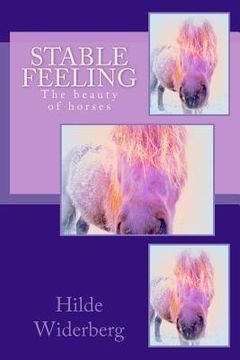Reseña del libro "Stable feeling: The beauty of horses (en Inglés)"
This is a tribute to our dear beautiful horses. The horse (Equus ferus caballus) is one of two extant subspecies of Equus ferus. It is an odd-toed ungulate mammal belonging to the taxonomic family Equidae. The horse has evolved over the past 45 to 55 million years from a small multi-toed creature into the large, single-toed animal of today. Humans began to domesticate horses around 4000 BC, and their domestication is believed to have been widespread by 3000 BC. Horses in the subspecies caballus are domesticated, although some domesticated populations live in the wild as feral horses. These feral populations are not true wild horses, as this term is used to describe horses that have never been domesticated, such as the endangered Przewalski's horse, a separate subspecies, and the only remaining true wild horse. There is an extensive, specialized vocabulary used to describe equine-related concepts, covering everything from anatomy to life stages, size, colors, markings, breeds, locomotion, and behavior. Horses' anatomy enables them to make use of speed to escape predators and they have a well-developed sense of balance and a strong fight-or-flight response. Related to this need to flee from predators in the wild is an unusual trait: horses are able to sleep both standing up and lying down. Female horses, called mares, carry their young for approximately 11 months, and a young horse, called a foal, can stand and run shortly following birth. Most domesticated horses begin training under saddle or in harness between the ages of two and four. They reach full adult development by age five, and have an average lifespan of between 25 and 30 years. Horse breeds are loosely divided into three categories based on general temperament: spirited "hot bloods" with speed and endurance; "cold bloods", such as draft horses and some ponies, suitable for slow, heavy work; and "warmbloods", developed from crosses between hot bloods and cold bloods, often focusing on creating breeds for specific riding purposes, particularly in Europe. There are more than 300 breeds of horse in the world today, developed for many different uses. Ponies are taxonomically the same animals as horses. The distinction between a horse and pony is commonly drawn on the basis of height, especially for competition purposes. However, height alone is not dispositive; the difference between horses and ponies may also include aspects of phenotype, including conformation and temperament. The traditional standard for height of a horse or a pony at maturity is 14.2 hands (58 inches, 147 cm). An animal 14.2 h or over is usually considered to be a horse and one less than 14.2 h a pony, but there are many exceptions to the traditional standard. In Australia, ponies are considered to be those under 14 hands (56 inches, 142 cm), The International Federation for Equestrian Sports, the world governing body for horse sport, uses metric measurements and defines a pony as being any horse measuring less than 148 centimetres (58.27 in) at the withers without shoes, which is just over 14.2 h, and 149 centimetres (58.66 in), or just over 14.21/2 h, with shoes. Height is not the sole criterion for distinguishing horses from ponies. Breed registries for horses that typically produce individuals both under and over 14.2 h consider all animals of that breed to be horses regardless of their height. Conversely, some pony breeds may have features in common with horses, and individual animals may occasionally mature at over 14.2 h, but are still considered to be ponies. Ponies often exhibit thicker manes, tails, and overall coat. They also have proportionally shorter legs, wider barrels, heavier bone, shorter and thicker necks, and short heads with broad foreheads. They may have calmer temperaments than horses and also a high level of equine intelligence that may or may not be used to cooperate with human handlers.

